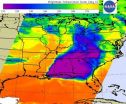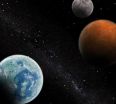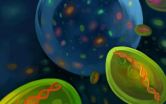(Press-News.org) SAN DIEGO (April 29, 2014) – Imagine filling a hole in your heart by regrowing the tissue. While that possibility is still being explored in people, it is a reality in salamanders. A recent discovery that newt hearts can regenerate may pave the way to new therapies in people who need to have damaged tissue replaced with healthy tissue.
Heart disease is the leading cause of deaths in the United States. Preventative measures like healthful diets and lifestyles help ward off heart problems, but if heart damage does occur, sophisticated treatments and surgical procedures often are necessary. Unfortunately, heart damage is typically irreversible, which is why researchers are seeking regenerative therapies that restore a damaged heart to its original capacity.
We have known for hundreds of years that newts and other types of salamanders regenerate limbs. If you cut off a leg or tail, it will grow back within a few weeks. Stanley Sessions, a researcher at Hartwich College in Oneonta, N.Y., wondered if this external phenomenon also took place internally. To find out, he surgically removed a piece of heart in more than two dozen newts.
"To our surprise, if you surgically remove part of the heart, (the creature) will regenerate a new heart within just six weeks or so," Sessions said. "In fact, you can remove up to half of the heart, and it will still regenerate completely!"
Before the research team dove deeper into this finding, Sessions and his three undergraduate students, Grace Mele, Jessica Rodriquez and Kayla Murphy, had to determine how a salamander could even live with a partial heart. It turns out that a clot forms at the surgical site, acting much like the cork in a wine bottle, to prevent the amphibian from bleeding to death.
What is the cork made of? In part, stem cells. Stem cells have unlimited potential for growth and can develop into cells with a specialized fate or function. Embryonic stem cells, for example, can give rise to all of the cells in the body and, thus, have promising potential for therapeutics.
As it turns out, stem cells play an important role in regeneration in newts. "We discovered that at least some of the stem cells for heart regeneration come from the blood, including the clot," Sessions explained.
This finding could have exciting implications for therapies in humans with heart damage. By finding the genes responsible for regeneration in the newt, researchers may be able to identify pathways that are similar in newts and people and could be used to induce regeneration in the human heart. In fact, a clinical trial performed just last year was the first to use stem-cell therapy to regenerate healthy tissue and repair a patient's heart.
Combining advances in medical and surgical technologies with the basic pathways of heart regeneration in newts could lead to better therapies for humans. Sessions posed this hopeful question: "Wouldn't it be great if we could find a way to activate heart stem cells to bioengineer new heart tissue so that we can actually repair damaged hearts in humans?"
INFORMATION:
Grace Mele will present the team's findings at the Experimental Biology 2014 meeting at 1:15 p.m. Tuesday, April 29, during the Cell Proliferation poster session (Poster #D370) in Exhibit Hall A-D, San Diego Convention Center.
About Experimental Biology 2014
Experimental Biology is an annual meeting comprised of more than 14,000 scientists and exhibitors from six sponsoring societies and multiple guest societies. With a mission to share the newest scientific concepts and research findings shaping current and future clinical advances, the meeting offers an unparalleled opportunity for exchange among scientists from throughout the United States and the world who represent dozens of scientific areas, from laboratory to translational to clinical research. http://www.experimentalbiology.org
About the American Society for Biochemistry and Molecular Biology (ASBMB)
ASBMB is a nonprofit scientific and educational organization with more than 12,000 members worldwide. Founded in 1906 to advance the science of biochemistry and molecular biology, the society publishes three peer-reviewed journals, advocates for funding of basic research and education, supports science education at all levels, and promotes the diversity of individuals entering the scientific workforce.
http://www.asbmb.org
Stem cells aid heart regeneration in salamanders
Finding raises hope for new therapies for people with heart damage
2014-04-29
ELSE PRESS RELEASES FROM THIS DATE:
Study confirms increased prevalence of GI symptoms among children with autism
2014-04-29
A new study conducted by researchers at Marcus Autism Center, Children's Healthcare of Atlanta and Emory University School of Medicine indicates that children with autism spectrum disorder (ASD) are more than four times more likely to experience general gastrointestinal (GI) complaints compared with peers, are more than three times as prone to experience constipation and diarrhea than peers, and complain twice as much about abdominal pain compared to peers.
The results were reported in the April 28, 2014, online early edition of the journal Pediatrics.
While parents ...
NASA satellite sees colder temperatures at tops of severe weather thunderstorms
2014-04-29
The weather system that dropped tornadoes in seven central and southern U.S. states on April 27-28, moved east and generated more tornadoes on April 29. NASA's Aqua satellite gathered temperature data on the thunderstorm cloud tops in the system and found them to be higher in the atmosphere and colder. The tornado outbreak over the evening and overnight hours of April 28-29 is thought to have generated more tornadoes in northern Mississippi and Alabama.
NASA's Aqua satellite passed over the eastern U.S. early in the morning on April 29 at 07:41 UTC/3:41 a.m. EDT and gathered ...
Search for extraterrestrial life more difficult than thought
2014-04-29
A new study from the University of Toronto Scarborough suggests the search for life on planets outside our solar system may be more difficult than previously thought.
The study, authored by a team of international researchers led by UTSC Assistant Professor Hanno Rein from the Department of Physical and Environmental Science, finds the method used to detect biosignatures on such planets, known as exoplanets, can produce a false positive result.
The presence of multiple chemicals such as methane and oxygen in an exoplanet's atmosphere is considered an example of a ...
NASA satellite spots tornado track near Conway, Ark.
2014-04-29
A violent tornado touched down in Arkansas on April 27, 2014, killing as many as 15 people. The top image, acquired on April 28 by the Moderate Resolution Imaging Spectroradiometer (MODIS) on NASA's Aqua satellite, shows what appears to be a tornado track north of Little Rock, Arkansas. The lower image, from April 25, shows the same area before the storm. The tracks are pale brown trails where trees and plants have been uprooted, leaving disturbed ground.
The difference in clarity between the two images is likely due to the centering of the scene beneath the satellite. ...
Preliminary results show improvement in MS symptoms
2014-04-29
Combining the estrogen hormone estriol with Copaxone, a drug indicated for the treatment of patients with relapsing forms of multiple sclerosis (MS), may improve symptoms in patients with the disorder, according to preliminary results from a clinical study of 158 patients with relapsing remitting multiple sclerosis (RRMS). The findings were presented today by Rhonda Voskuhl, M.D., from the University of California, Los Angeles, at the American Academy of Neurology Annual Meeting in Philadelphia. The study was funded by the National Institute of Neurological Disorders and ...
Octillions of microbes in the seas: Ocean microbes show incredible genetic diversity
2014-04-29
The smallest, most abundant marine microbe, Prochlorococcus, is a photosynthetic bacterial species essential to the marine ecosystem.
It's estimated that billions of the single-celled creatures live in the oceans, forming the center of the marine food web.
They occupy a range of ecological niches based on temperature, light, water chemistry and interactions with other species.
But the diversity within this single species remains a puzzle.
To probe this question, scientists at the Massachusetts Institute of Technology (MIT) recently performed a cell-by-cell genomic ...
Consuming high-protein breakfasts helps women maintain glucose control, MU study finds
2014-04-29
COLUMBIA, Mo. – In healthy individuals, the amount of glucose, or sugar, in the blood increases after eating. When glucose increases, levels of insulin increase to carry the glucose to the rest of the body. Previous research has shown that extreme increases in glucose and insulin in the blood can lead to poor glucose control and increase an individual's risk of developing diabetes over time. Now, a University of Missouri researcher has found that when women consumed high-protein breakfasts, they maintained better glucose and insulin control than they did with lower-protein ...
New data suggest potassium & dietary fiber intake among toddlers should be priority
2014-04-29
(SAN DIEGO, CA) April 29, 2014 – Recommendations to increase the intake of potassium and dietary fiber among young children should be a priority for the 2020 Dietary Guidelines for Americans, according to a new study by the Alliance for Potato Research and Education (APRE) presented today at Experimental Biology 2014.
While the federal Dietary Guidelines has focused on adults and children 2 years of age and older, the 2020 Dietary Guidelines will include Americans of all ages, starting from birth, noted Maureen Storey, PhD, co-author of the study and APRE president and ...
Two-part special issue of Ergonomics in Design highlights climate change
2014-04-29
Human factors/ergonomics (HF/E) experts, like professionals in many other scientific domains, have joined the fight against global warming and climate change. Their research and practice focus on finding ways to combat or minimize its serious effects.
A special two-part issue of Ergonomics in Design examines how HF/E professionals can continue working to mitigate this worldwide phenomenon. Part 1 of the special issue, guest edited by Ken Nemire, is now available online and may be found at http://erg.sagepub.com/.
"With recent research indicating we stay close to ...
NRL researchers develop harder ceramic for armor windows
2014-04-29
The Department of Defense needs materials for armor windows that provide essential protection for both personnel and equipment while still having a high degree of transparency. To meet that need, scientists at the Naval Research Laboratory (NRL) have developed a method to fabricate nanocrystalline spinel that is 50% harder than the current spinel armor materials used in military vehicles. With the highest reported hardness for spinel, NRL's nanocrystalline spinel demonstrates that the hardness of transparent ceramics can be increased simply by reducing the grain size to ...
LAST 30 PRESS RELEASES:
B cells transiently unlock their plasticity, risking lymphoma development
Advanced AI dodel predicts spoken language outcomes in deaf children after cochlear implants
Multimodal imaging-based cerebral blood flow prediction model development in simulated microgravity
Accelerated streaming subgraph matching framework is faster, more robust, and scalable
Gestational diabetes rose every year in the US since 2016
OHSU researchers find breast cancer drug boosts leukemia treatment
Fear and medical misinformation regarding risk of progression or recurrence among patients with breast cancer
Glucagonlike peptide-1 receptor agonists and asthma risk in adolescents with obesity
Reviving dormant immunity: Millimeter waves reprogram the immunosuppressive microenvironment to potentiate immunotherapy without obvious side effects
Safety decision-making for autonomous vehicles integrating passenger physiological states by fNIRS
Fires could emit more air pollution than previously estimated
A new way to map how cells choose their fate
Numbers in our sights affect how we perceive space
SIMJ announces global collaborative book project in commemoration of its 75th anniversary
Air pollution exposure and birth weight
Obstructive sleep apnea risk and mental health conditions among older adults
How talking slows eye movements behind the wheel
The Ceramic Society of Japan’s Oxoate Ceramics Research Association launches new international book project
Heart-brain connection: international study reveals the role of the vagus nerve in keeping the heart young
Researchers identify Rb1 as a predictive biomarker for a new therapeutic strategy in some breast cancers
Survey reveals ethical gaps slowing AI adoption in pediatric surgery
Stimulant ADHD medications work differently than thought
AI overestimates how smart people are, according to HSE economists
HSE researchers create genome-wide map of quadruplexes
Scientists boost cell "powerhouses" to burn more calories
Automatic label checking: The missing step in making reliable medical AI
Low daily alcohol intake linked to 50% heightened mouth cancer risk in India
American Meteorological Society announces Rick Spinrad as 2026 President-Elect
Biomass-based carbon capture spotlighted in newly released global climate webinar recording
Illuminating invisible nano pollutants: advanced bioimaging tracks the full journey of emerging nanoscale contaminants in living systems
[Press-News.org] Stem cells aid heart regeneration in salamandersFinding raises hope for new therapies for people with heart damage




